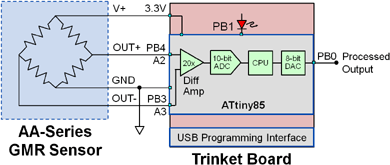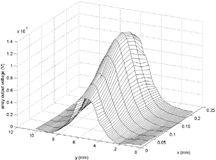|
Daylight
Saving Time
begins Sunday, March 11. Set your clocks forward an hour. |
|
|
|
|
|
 |
|
Inexpensive
Microcontroller Interfaces |
|
|
With their high output signals, GMR sensors are easy to interface to inexpensive
eight-bit microcontrollers. The ATtiny85 is a popular choice because it has an
available differential amplifier with a selectable gain of 20; has I2C, PWM, and
digital I/O; it has an internal temperature sensor that can be used for temperature
compensation in critical applications; and costs less than $1.00.
The gain of 20 is ideal for NVE GMR analog sensors. AALSeries sensors, for example,
have a maximum output of 45 mV/V, so a gain of 20 provides 900 mV/V, or nearly
full scale. That means all 10 bits of microcontroller ADC resolution are used.
The ATtiny85 only has eight pins microcontroller, but that’s enough to interface
to the sensor and provide digital and PWM outputs.
Microchip offers a development
environment and evaluation kits, and there are several single-board computers
such as Trinket and Little Wire boards.
Here’s a typical interface using a Trinket board:

AA-Sensor Interface to Low-End Microcontroller
Here’s a live demonstration
of the circuit above, including a simple Arduino program to
amplify, offset correct, and temperature compensate the outputs:
|
 |
|
In
the News:
Nondestructive Evaluation |
|
|

With their high sensitivity and low noise, NVE analog sensors are popular for
nondestructive evaluation.
Here are some examples of publicly-available papers describing applications:
Visit our “Case Studies”
Webpage for More >
Download our Analog
Sensor Datasheet >

|
 |
|
Upcoming
Exhibitions |
|
|

NVE distributor Hy-Line
Power will display NVE products at Embedded World, February 27
to March 1, at Halle 1/Stand 170, Messe Nürnberg, Germany.
Featured new products will include the IL3685-1E
40 Mbps Ultrahigh Speed QSOP Transceiver and IL2985E
Low-Power Transceiver.
|
 |
|
Pi
Day Applications |
|
|
In honor of Pi Day
3/14, here’s a calculation for AAT-Series
angle sensors:
The equation defines the angle, in degrees, from an AAT sensor’s two outputs.
Since the arctangent is the ratio of the two outputs, power and temperature effects
tend to cancel. The two-variable arctangent function provides a full 360-degree
angle range.
Here’s
a video with more information. |
|







